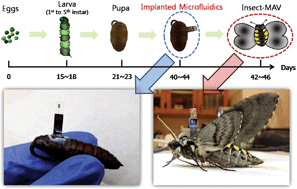Engineering insect flight metabolics using immature stage implanted microfluidics†
Abstract
Small-scale insect inspired aircraft represent a promising approach to downscaling traditional aircraft designs. Despite advancements in microfabrication, however, it has proven difficult to fully replicate the mechanical complexities that enable these natural systems. As an alternative, recent efforts have used implanted electrical, optical or acoustic microsystems to exert direct control over insect flight. Here we demonstrate, for the first time, a method of directly and reversibly engineering insect flight metabolics using immature stage implanted microfluidics. We present our technique and device for on-command modulation of the internal levels of L-glutamic and L-aspartate acids and quantify the resulting changes in metabolic activity by monitoring respiratory CO2 output. Microfluidic devices implanted 1 to 2 days prior to insects' emergence achieved survivability and flight-capable rates of 96% and 36%, respectively. Behavior ranging from retarded motion to complete, reversible paralysis, over timescales ranging from minutes to hours is demonstrated.


 Please wait while we load your content...
Please wait while we load your content...